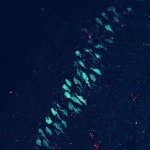Link to Pubmed [PMID] – 8845152
Neuron 1995 Dec;15(6):1275-85
The stereotyped positions occupied by individual classes of neurons are a fundamental characteristic of CNS cytoarchitecture. To study the regulation of neuronal positioning, we injected genetically labeled neural precursors derived from dorsal and ventral mouse forebrain into the telencephalic vesicles of embryonic rats. Cells from both areas were found to participate in the generation of telencephalic, diencephalic, and mesencephalic brain regions. Donor-derived neurons populated the host brain in distinct patterns and acquired phenotypic features appropriate for their final location. These observations indicate that neuronal migration and differentiation are predominantly regulated by non-cell-autonomous signals. Exploiting this phenomenon, intrauterine transplantation allows generation of controlled chimerism in the mammalian brain.

